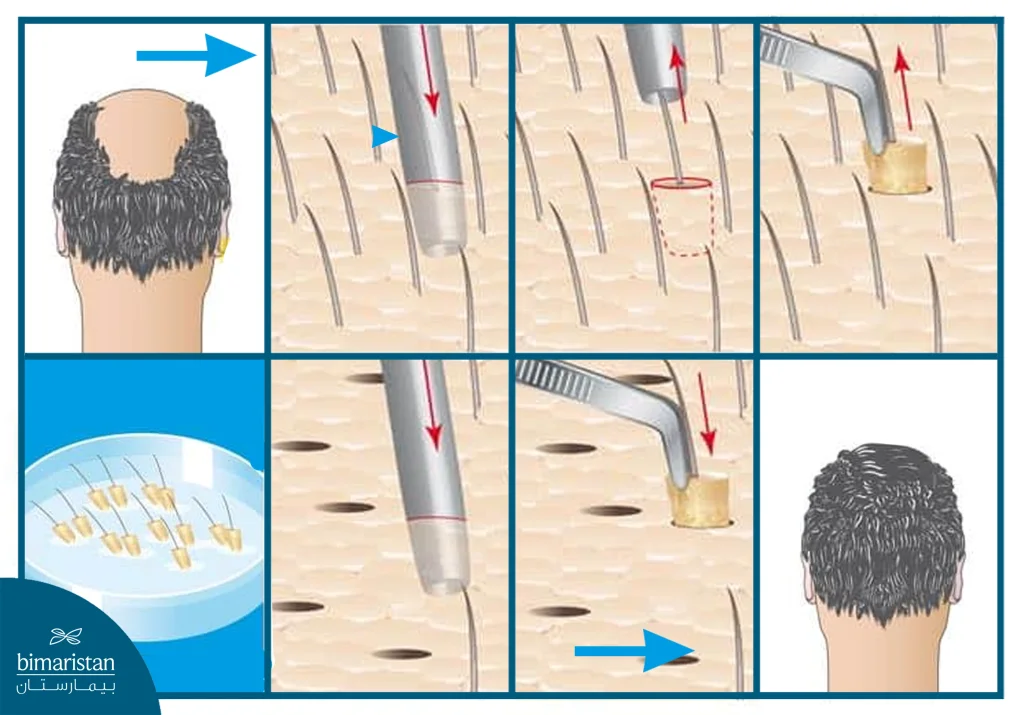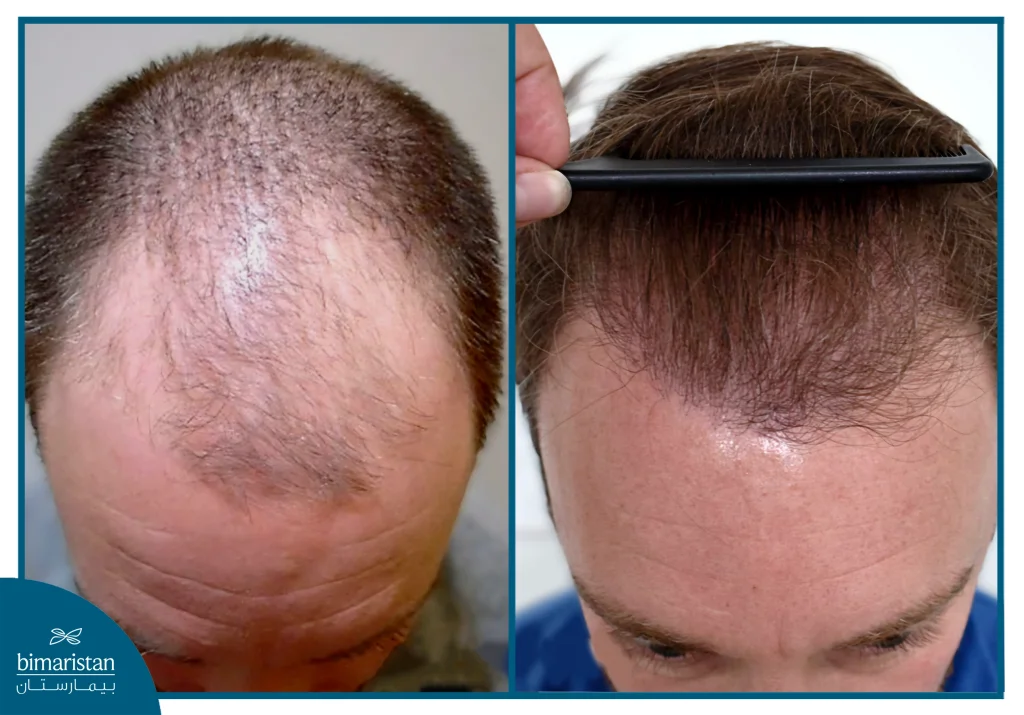Nano hair transplant is one of the most advanced and precise hair restoration techniques available today, utilizing ultra-fine instruments to extract and implant grafts with exceptional accuracy and minimal scarring. This method marks a significant breakthrough over conventional approaches like FUE and DHI, delivering highly natural results, particularly along the frontal hairline, with increased density and a shorter recovery time.
What is a nano hair transplant?
Nano hair transplant is an advanced hair transplant technique in Turkey that uses nanomaterials to enhance the effectiveness of the procedure. This technique helps improve the body’s ability to receive transplanted follicles and stimulate faster, denser hair growth.
It involves the individual extraction of hair follicles from a designated donor area of the scalp, typically the back or sides, using a specialized device equipped with ultra-precise heads. These tools facilitate the smooth transfer of follicles to the bald or recipient areas, minimizing follicle loss and reducing pain compared to conventional methods. In this technique, the hair is carefully cleaned and treated with dedicated instruments, then prepared for transplantation into the targeted zones.
The following table shows a comparison between nano hair transplant and conventional hair transplant:
| Feature | Nano | Conventional |
|---|---|---|
| The size of the channels | much smaller | Larger |
| Scars | Almost nonexistent | Possible |
| Natural appearance | More accurate and realistic | Good but less accurate |
| Density | Top | less |
| Recovery | Faster | slower |
Advantages of nano hair transplant
There are several advantages of nanotechnology for hair transplantation, including:
- Enhanced healing speed: Nanotechnology accelerates healing and reduces recovery time compared to conventional methods.
- Reduced pain and bleeding: Advanced precision instruments minimize pain and bleeding during and after the procedure.
- Increased hair density: Nano hair transplant can achieve a higher hair density than other methods, improving overall appearance.
- Improved results: Nanotechnology enhances the quality of transplanted follicles, ensuring they grow properly and resulting in natural, lasting results.
- This technique can deliver excellent results in mustache, eyebrow, and beard transplants, and even surpasses scalp hair transplants, achieving 100% success.
- This technique involves extracting hair from the scalp by creating a tiny, invisible incision. As a result, the invisible scars do not impact the appearance, growth, or density of the hair following the procedure.
- Scar-free finish: One of the advantages of nano hair transplant is that it does not result in scalp, chin, or mustache scarring or disfigurement, which is a concern for many undergoing hair transplant.
Nano hair transplant steps
The steps of nano hair transplant are numerous and may have similarities with other conventional techniques.
- Hairline planning step: In this stage, a hairline is first drawn and its direction is determined; the appropriate hair color, shade, density, and depth are then determined, and once these are finalized, the following steps proceed.
- Local anesthesia: Nano hair transplant relies on local anesthesia applied to both the donor and recipient areas approximately 15 minutes before the procedure begins.
- The step of extracting hair follicles from the donor area: This is the most critical stage in the nano hair transplant procedure.
- A nano extraction tool is used, specifically designed to extract hair painlessly. Follicles are extracted with a diameter ranging from 0.7 to 1 mm, without manual contact.
- This process takes about two to three hours, during which the hair grafts are formed.
- The final step in this stage involves the physician covering the donor area to protect it.
- The grafts are then preserved in a suitable solution and environment to prevent damage until they are transplanted into the recipient area.
- Channel Opening Stage: This is the next and penultimate step.
- Channels are opened in the recipient area using a cosmetic technique that avoids scarring. These channels are created with an invisible diameter of 0.4-0.5 mm.
- Each channel is precisely aligned with the angle of natural hair growth to ensure proper integration of the transplanted grafts.
- This stage typically lasts up to 1.5 hours, depending on the physician’s skill and experience.
- Hair transplant step in the recipient area: This is the final stage of the nano hair transplant procedure.
- Hair is implanted into the previously opened channels, following the correct growth direction and the planned hairline.
- The physician places the grafts in the frontal line to achieve a natural look. Remaining grafts are implanted using double- and triple-follicle techniques in the top and back scalp areas to ensure uniform density.
- This step usually takes around two to three hours or more, depending on the expertise of the medical team performing the procedure.

Suitable cases for nano hair transplant
Nano hair transplant is ideal for the following conditions:
- No chronic diseases
- People with hair loss who are under the age of 60
- Heavy hair loss due to hereditary baldness
- Women of all ages who suffer from hair loss or baldness
- Mustache, eyebrow, and beard transplants with 100% results
- Premature genetic baldness or hormonal hair loss under the age of twenty
The difference between nano hair transplant and other techniques
The following table shows a comparison of different hair transplant techniques:
| Feature | Nano | Conventional FUE | DHI (Direct Hair Implantation) | Robotic Hair Transplant (ARTAS) |
|---|---|---|---|---|
| Extraction method | Ultra-fine (less than 1 millimeter) nanoscale tools | Larger diameter hand or machine tools | Using Choi pens to open canals and transplant follicles at the same time | ARTAS robot uses artificial intelligence to select and extract follicles |
| Transplant method | manually using precision tools | manually or using mechanical devices | Using Choi pens that open the ducts and directly transplant the follicles | ARTAS robot transplants grafts using pre-programmed techniques |
| Scars | Almost nonexistent | Small scars that may be visible | Virtually no scarring | Tiny scars |
| Natural appearance | very good, especially in the front hairline | Good, but may be less accurate in distributing hair | Excellent, especially in delicate areas such as eyebrows and beard | Good, but may lack precision in the design of the front hairline |
| Density | High, thanks to precision tools | Good, but lower compared to Nano, FUE, and DHI | High, thanks to the use of Choi pens | Good, but lower compared to Nano and DHI |
| Cost | higher, due to the use of advanced tools and techniques | Less, varies by technology | Higher, due to the use of Choi pens and advanced techniques | Higher, due to the cost of hardware and software |
Nano hair transplant results
The following table shows the time period for each stage after a hair transplant:
| Time period | Details |
|---|---|
| First week | The scalp may be swollen, red, and painful during the first week, and scabs form around the transplanted follicles, which often fall off within 7 to 10 days. Gently wash the hair after 48 hours, and the swelling and redness will begin to subside by the end of the week. |
| Week 2-4 | Known as the “shock shedding phase”, most of the transplanted hair falls off during this period. This is a natural phase caused by the follicles entering a resting phase. |
| Month 2-3 | New hair begins to grow from the transplanted follicles, usually thin and colorless at first, then becomes thicker and stronger over time as blood flow begins to nourish the follicles, preparing them for growth, and the doctor recommends taking supplements to support growth. |
| Month 6-9 | Hair becomes thicker, fills the gaps more distinctly, and styling options expand. It’s important to maintain your hair care routine for improved and quicker results, while the hairline gradually begins to take shape. |
| Month 12-18 | Most people reach the final density and achieve a natural final look. |

A natural-looking front hairline appearance
Nanotechnology is characterized by its high precision in the extraction and transplant of grafts, allowing the direction of hair growth to be precisely determined, especially in the frontal area, which contributes to a natural and harmonious frontal line with the rest of the hair.
Nano hair transplant risks and side effects
While nano hair transplant offers several benefits, it also has drawbacks, including:
- When performing nano hair transplant, the number of transplanted hair follicles in the recipient area should not exceed 4,000. Therefore, it is essential to select a physician who specializes in this technique to avoid unnecessary loss of these relatively limited follicles.
- This technique is not suitable for hair transplant in the elderly, as it can be dangerous, and if performed, may not yield strong results.
- Unlike conventional techniques that may work for all cases, many cases are not suitable, including adults with chronic illnesses such as
- Diabetes
- All types of cancer
- High blood pressure
- Heart disease and atherosclerosis
- Viral hepatitis
- Diseases requiring chemotherapy or radiation therapy
- Temporary swelling or redness, and loss of some follicles
Recovery period after nano hair transplant
After completing the hair transplant process, the doctor provides medical tips to accelerate healing, recovery, and the appearance of the final results. Tips include:
- Taking pain medications
- Your doctor may prescribe a medication to increase hair growth, such as minoxidil
- Take the antibiotics prescribed by your doctor to minimize the risk of infection after the procedure
- The transplanted hair falls off 3 weeks after the procedure, and there is no need to worry about this natural hair loss, as it grows back within 8 months or a year at most, naturally and thickly, without any issues
During the recovery and convalescence period following a nano hair transplant procedure, it is essential to closely monitor your health. If any side effects occur, you should consult a specialist to adjust your medication dosage. This recovery phase is crucial, as it significantly impacts the final results of the hair transplant. Proper care and attention during this time are key factors that influence the outcomes of the procedure.
Nano hair transplant cost in Turkey
Turkey is a popular destination for nano hair transplants, thanks to its affordable prices: nano hair transplants cost between $1,500 and $4,000 USD, depending on the clinic, the number of grafts, and additional services such as accommodation and transportation.
| Country | Average Cost (USD) |
|---|---|
| Turkey | 2,500 – 5,000 |
| United States | 13,000 – 16,000 |
| United Kingdom | 15,500- 17000 |
| Germany | 6,000 – 12,000 |
Nano hair transplant cost comparison between Turkey and other countries
The following table shows a comparison of the cost of nano hair transplant between Turkey and other countries:
In conclusion, nano hair transplant has demonstrated remarkable effectiveness, delivering natural-looking results and high hair density through its advanced precision. It stands out as the ideal choice for individuals seeking a modern and long-lasting solution to hair loss. To ensure optimal outcomes, it is always recommended to consult a qualified specialist who can evaluate each case and tailor a treatment plan suited to each patient.
Sources:
- Correia, M., Lopes, J., Lopes, D., Melero, A., Makvandi, P., Veiga, F., Coelho, J. F. J., Fonseca, A. C., & Paiva-Santos, A. C. (2023, November). Nanotechnology-based techniques for hair follicle regeneration. Biomaterials, 302, 122348
- MedlinePlus. (2025, February 5). Hair transplant. U.S. National Library of Medicine.
